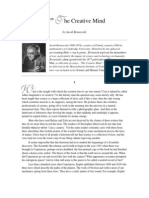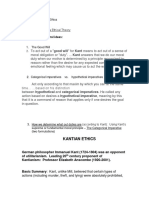100%(2)100% found this document useful (2 votes)
Koestler Arthur - Lunaticii
Koestler Arthur - Lunaticii
Uploaded by
cristi4uglThe document provides a review of Arthur Koestler's 1959 book "The Sleepwalkers" which details the history of scientific ideas about the universe. The review summarizes that Koestler traces the evolution of cosmic theories from the Ionian Greeks through Copernicus, Kepler, Galileo and Newton. It notes that Koestler focuses on the human and psychological factors involved in scientific discovery. The review also discusses themes in the book around the divide between faith and reason and Koestler's perspective that sees puppets of either God or chromosomes as tragic figures. It concludes that while the book does not impose regular patterns of evolution, it provides an anthropocentric view of humanity facing the mysteries of the universe.
Copyright:
Attribution Non-Commercial (BY-NC)
Available Formats
Download as PDF, TXT or read online from Scribd
Download as pdf or txt
Koestler Arthur - Lunaticii
Koestler Arthur - Lunaticii
Uploaded by
cristi4ugl100%(2)100% found this document useful (2 votes)
The document provides a review of Arthur Koestler's 1959 book "The Sleepwalkers" which details the history of scientific ideas about the universe. The review summarizes that Koestler traces the evolution of cosmic theories from the Ionian Greeks through Copernicus, Kepler, Galileo and Newton. It notes that Koestler focuses on the human and psychological factors involved in scientific discovery. The review also discusses themes in the book around the divide between faith and reason and Koestler's perspective that sees puppets of either God or chromosomes as tragic figures. It concludes that while the book does not impose regular patterns of evolution, it provides an anthropocentric view of humanity facing the mysteries of the universe.
Original Title
Koestler Arthur- Lunaticii
Copyright
© Attribution Non-Commercial (BY-NC)
Available Formats
PDF, TXT or read online from Scribd
Share this document
Did you find this document useful?
Is this content inappropriate?
The document provides a review of Arthur Koestler's 1959 book "The Sleepwalkers" which details the history of scientific ideas about the universe. The review summarizes that Koestler traces the evolution of cosmic theories from the Ionian Greeks through Copernicus, Kepler, Galileo and Newton. It notes that Koestler focuses on the human and psychological factors involved in scientific discovery. The review also discusses themes in the book around the divide between faith and reason and Koestler's perspective that sees puppets of either God or chromosomes as tragic figures. It concludes that while the book does not impose regular patterns of evolution, it provides an anthropocentric view of humanity facing the mysteries of the universe.
Copyright:
Attribution Non-Commercial (BY-NC)
Available Formats
Download as PDF, TXT or read online from Scribd
Download as pdf or txt
100%(2)100% found this document useful (2 votes)
Koestler Arthur - Lunaticii
Koestler Arthur - Lunaticii
Uploaded by
cristi4uglThe document provides a review of Arthur Koestler's 1959 book "The Sleepwalkers" which details the history of scientific ideas about the universe. The review summarizes that Koestler traces the evolution of cosmic theories from the Ionian Greeks through Copernicus, Kepler, Galileo and Newton. It notes that Koestler focuses on the human and psychological factors involved in scientific discovery. The review also discusses themes in the book around the divide between faith and reason and Koestler's perspective that sees puppets of either God or chromosomes as tragic figures. It concludes that while the book does not impose regular patterns of evolution, it provides an anthropocentric view of humanity facing the mysteries of the universe.
Copyright:
Attribution Non-Commercial (BY-NC)
Available Formats
Download as PDF, TXT or read online from Scribd
Download as pdf or txt
You are on page 1/ 2
Author: Arthur KOESTLER
Title: The Sleepwalkers
Year: 1959
Published:
Review by: Laura PETRA
3rd year Law student, MA student in Psychology
“...when all the stars were ready to be placed in the sky the First Woman said: I will use these to
write the laws that are given to mankind for all time. They cannot be written on the water as it is
always changing its form, nor can they be written in the sand as the wind would soon erase them,
but if they are written in the stars, they can be read and remembered forever.”
Navajo creation story, from G. Johnson, Fire in the Mind
In Arthur Koestler’s The Sleepwalkers (1959), we discover an account of the history of
science as it is reflected in the evolution of ideas about the Universe. The journey begins with the
heroic age of the Ionian Greeks, with a dark interlude in the Middle Ages and resuming its track in
the sixteen century with Copiernicus, Kepler, Galileo and finally Newton. The metaphor that
pervades the entire chronicle is the image of a pendulum: once removed from its equilibrium state,
it doesn’t return to its original position, but instead it is propelled in the opposite direction.
Koestler’s life trajectory follows a similar path: once he disengages from his explicit sympathy
towards communism through the famous book Darkness at Noon, he focuses on science and
philosophy (The Trail of the Dinosaur-1955, The Ghost in the Machine-1967), only to orient
himself towards the end of his life to spirituality and mysticism (The Roots of Coincidence-1972).
His account is neither detached, nor neutral: he focuses on the human factor and on the
psychological process of discovery, uncovering both the revelations and the moments of blindness
to obvious truths that undermine the image of the scientist as a rational, equilibrated, almost non-
human creature. In his words: “the history of cosmic theories can be called, without exaggeration, a
history of collective obsessions and controlled schizophrenias, and the manner in which some
discoveries have been made resemble the conduct of a sleepwalker, rather than the performance of
an electronic brain.”
Another theme of the book is the insidious divorce between faith and reason, between the
mystic and the savant, both driven in life by the need to be protected and freed at the same time, but
estranged with the passage of time: “the space-spirit hierarchy has gradually been replaced by the
space-time continuum.” He anticipates the Decade of the Brain, and as an expression of his position
against a strict Darwinia n evolutionism, his final remark in this book is bittersweet: “If a puppet
manipulated by God is a tragic figure, a puppet tied to its own chromosomes is grotesque”.
One peculiarity of this well-documented, memorable journey through the history of ideas
about the Cosmos is the fact that the author escapes the tendency to see or impose regularities,
patterns of evolution, which is an inherent temptation of any global vision upon the history of
science - as George Johnson stated in Fire in the Mind: “Just as nature abhors a vacuum, the human
mind abhors randomness”. The only constant approach that can be noticed is the importance
assigned to human factors and to the surrounding context that provides some of their driving forces:
from this perspective, the universe that Koestler created in his book The Sleepwalkers can be
considered anthropocentric. And even if one does not embrace all the details and the hypothesis
offered by this account, the fact remains that the book is a remarkable picture of human nature
facing the mysteries of the Universe.
You might also like
- Psyche and Singularity - Timothy DesmondNo ratings yetPsyche and Singularity - Timothy Desmond366 pages
- Thinking in Constellations Walter Benjamin in The Humanities (Caroline Sauter Nassima Sahraoui) (Z-Library)No ratings yetThinking in Constellations Walter Benjamin in The Humanities (Caroline Sauter Nassima Sahraoui) (Z-Library)247 pages
- The universe is intelligent. The soul exists. Quantum mysteries, multiverse, entanglement, synchronicity. Beyond materiality, for a spiritual vision of the cosmos.From EverandThe universe is intelligent. The soul exists. Quantum mysteries, multiverse, entanglement, synchronicity. Beyond materiality, for a spiritual vision of the cosmos.1/5 (1)
- Art Education Edtpa Lesson Plan Template Lesson: - 1 - Author: - Amberlynn Bishop - Grade Level: 9-12No ratings yetArt Education Edtpa Lesson Plan Template Lesson: - 1 - Author: - Amberlynn Bishop - Grade Level: 9-123 pages
- Until the End of Time_ Mind, Matter, and Our Search for Meaning in an Evolving Universe_summaryNo ratings yetUntil the End of Time_ Mind, Matter, and Our Search for Meaning in an Evolving Universe_summary204 pages
- Listening To Anima Mundi: The Organic Metaphor in The Cosmoecological PerspectiveNo ratings yetListening To Anima Mundi: The Organic Metaphor in The Cosmoecological Perspective23 pages
- A Review of Slavoj Zizek's Living in The End TimesNo ratings yetA Review of Slavoj Zizek's Living in The End Times8 pages
- The Universe is Intelligent. The Soul Exists. Quantum Mysteries, Multiverse, Entanglement, Synchronicity. Beyond Materiality, for a Spiritual Vision of the Cosmos.: Quantum mysteries, multiverse, entanglement, synchronicity. Beyond materiality, for a spiritual vision of the cosmos.From EverandThe Universe is Intelligent. The Soul Exists. Quantum Mysteries, Multiverse, Entanglement, Synchronicity. Beyond Materiality, for a Spiritual Vision of the Cosmos.: Quantum mysteries, multiverse, entanglement, synchronicity. Beyond materiality, for a spiritual vision of the cosmos.No ratings yet
- Cosmic Horror, Gothic Body and The Text The Sahow Over InnsmouthNo ratings yetCosmic Horror, Gothic Body and The Text The Sahow Over Innsmouth12 pages
- A_Hundred_Sessions_in_Yeoldelands_-_Digital_-_v1.0No ratings yetA_Hundred_Sessions_in_Yeoldelands_-_Digital_-_v1.08 pages
- The Myth of Sisyphus by Albert Camus (Book Analysis): Detailed Summary, Analysis and Reading GuideFrom EverandThe Myth of Sisyphus by Albert Camus (Book Analysis): Detailed Summary, Analysis and Reading GuideNo ratings yet
- Elaborato Sul Concetto Di Tempo e Memoria in Letteratura Inglese e SpagnolaNo ratings yetElaborato Sul Concetto Di Tempo e Memoria in Letteratura Inglese e Spagnola7 pages
- The Inside Outsiders in The Stranger and DayNo ratings yetThe Inside Outsiders in The Stranger and Day5 pages
- Conspectus of The Qu From All Tomorrows and The Possibility of An Expanded UniverseNo ratings yetConspectus of The Qu From All Tomorrows and The Possibility of An Expanded Universe16 pages
- Coomaraswamy - The Man, Myth and History (Whitall N. Perry) PDFNo ratings yetCoomaraswamy - The Man, Myth and History (Whitall N. Perry) PDF7 pages
- Memories of Origination Survival PrisonNo ratings yetMemories of Origination Survival Prison11 pages
- Adventures in Space (Short stories by Chinese and English Science Fiction writers)From EverandAdventures in Space (Short stories by Chinese and English Science Fiction writers)4/5 (2)
- The Limit of Human Nature in Huxley and Leguin's WorksNo ratings yetThe Limit of Human Nature in Huxley and Leguin's Works2 pages
- Grzybek (1994) - The Culture of Nature - The Semiotic Dimensions of Microcosm, Mesocosm, and MacrocosmNo ratings yetGrzybek (1994) - The Culture of Nature - The Semiotic Dimensions of Microcosm, Mesocosm, and Macrocosm10 pages
- Albert Camus and The Ethics of Moderation: Lana StarkeyNo ratings yetAlbert Camus and The Ethics of Moderation: Lana Starkey17 pages
- Berlinsky 1996 Was There A Big Bang PDFNo ratings yetBerlinsky 1996 Was There A Big Bang PDF11 pages
- 2017 Cosmology or Chaosmology Review of PDFNo ratings yet2017 Cosmology or Chaosmology Review of PDF3 pages
- In Civilized Places.: Paths Toward A Clearing: Radical Empiricism and EthnographicNo ratings yetIn Civilized Places.: Paths Toward A Clearing: Radical Empiricism and Ethnographic2 pages
- The Swerve - How The World Became Modern - by Stephen Greenblatt - Book Review - NYTimes50% (2)The Swerve - How The World Became Modern - by Stephen Greenblatt - Book Review - NYTimes5 pages
- The Terror and The Terroir The EcologicaNo ratings yetThe Terror and The Terroir The Ecologica12 pages
- Existential Investigation Gregory Kimbrell PDFNo ratings yetExistential Investigation Gregory Kimbrell PDF17 pages
- Dreams of Other Worlds: The Amazing Story of Unmanned Space Exploration - Revised and Updated EditionFrom EverandDreams of Other Worlds: The Amazing Story of Unmanned Space Exploration - Revised and Updated Edition4/5 (4)
- Man and Nature The Spiritual Crisis in Modern Man - Book Review4233No ratings yetMan and Nature The Spiritual Crisis in Modern Man - Book Review42333 pages
- Collins Sail On! Sail On! (Science Fiction Studies v30 2003)No ratings yetCollins Sail On! Sail On! (Science Fiction Studies v30 2003)20 pages
- The Sleepwalkers: The Sleepwalkers: A History of Man's Changing Vision of The UniverseNo ratings yetThe Sleepwalkers: The Sleepwalkers: A History of Man's Changing Vision of The Universe2 pages
- From the Eternal Recurrence to the PosthNo ratings yetFrom the Eternal Recurrence to the Posth11 pages
- The Call of Cthulhu: A Futuristic Science-Fiction Myth Infecting The Reader WithNo ratings yetThe Call of Cthulhu: A Futuristic Science-Fiction Myth Infecting The Reader With9 pages
- Dying Becomes Her Posthumanism in SophocNo ratings yetDying Becomes Her Posthumanism in Sophoc21 pages
- Maskens, Blanes - 2013 - Dom Quixote's choice A manifesto for a romanticist anthropologyNo ratings yetMaskens, Blanes - 2013 - Dom Quixote's choice A manifesto for a romanticist anthropology37 pages
- Teacher Teaching Dates and Time Grade Level Learning Area QuarterNo ratings yetTeacher Teaching Dates and Time Grade Level Learning Area Quarter3 pages
- 20-Point Quiz Lesson 2 Anthro, Socio, Polsci100% (1)20-Point Quiz Lesson 2 Anthro, Socio, Polsci21 pages
- Theory in Anthropology Since Sherry OrtnerNo ratings yetTheory in Anthropology Since Sherry Ortner4 pages
- Alasdair MacIntyre On Thomism and The STNo ratings yetAlasdair MacIntyre On Thomism and The ST24 pages
- Advanced Research Methods and Techniques (ARMT)100% (1)Advanced Research Methods and Techniques (ARMT)15 pages
- The Foundations of Quantum Mechanics in The Philosophy of Nature PDFNo ratings yetThe Foundations of Quantum Mechanics in The Philosophy of Nature PDF10 pages
- Workbook for Principles of Microeconomics 1st Edition Martin Kolmar All Chapters Instant Download100% (1)Workbook for Principles of Microeconomics 1st Edition Martin Kolmar All Chapters Instant Download55 pages
- Research Methodology: Presented By-Shobha SinghNo ratings yetResearch Methodology: Presented By-Shobha Singh19 pages
- Naturalistic Generalizations: Robert E. Stake and Deborah J. Trumbull100% (2)Naturalistic Generalizations: Robert E. Stake and Deborah J. Trumbull7 pages

























































































